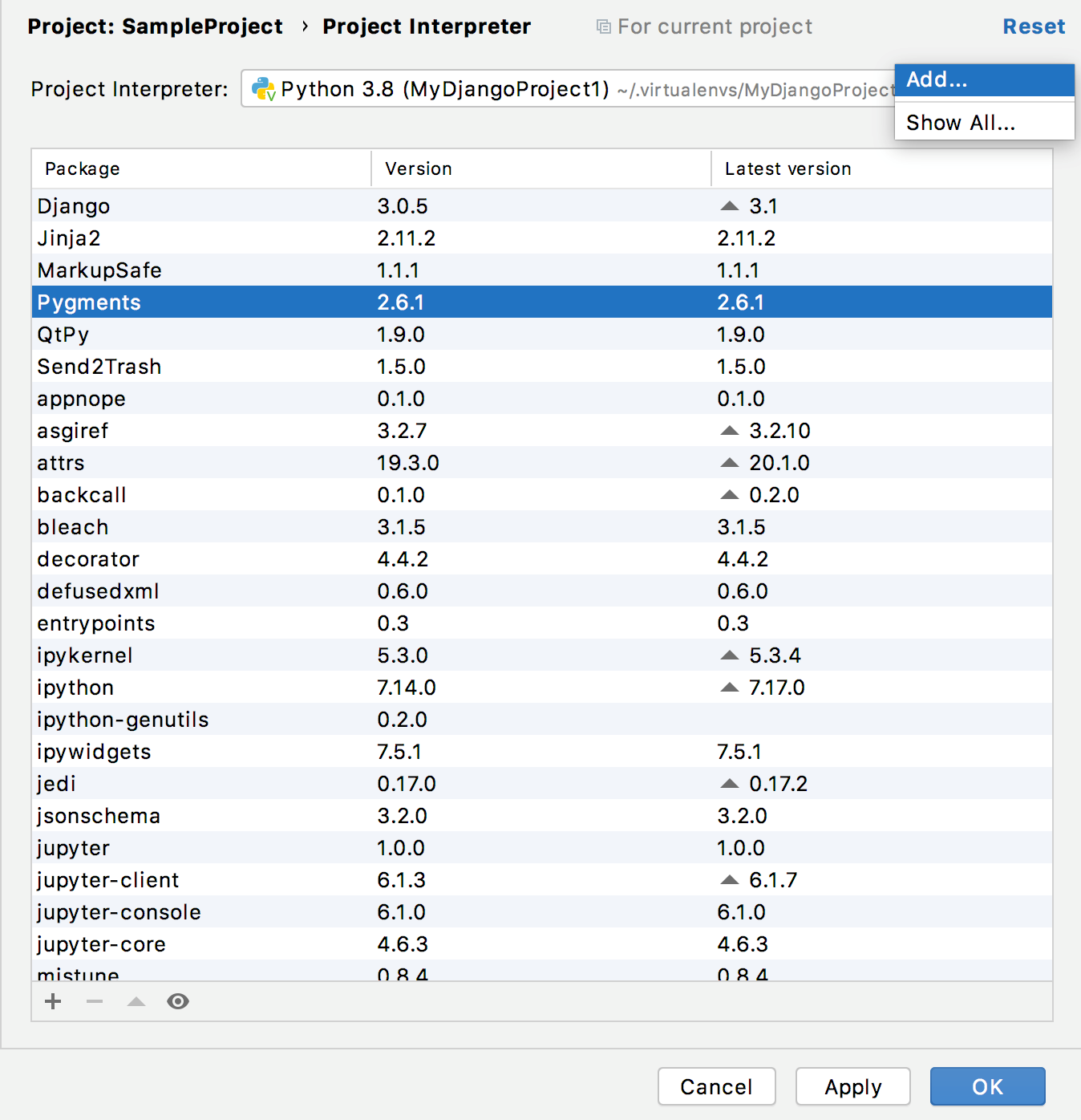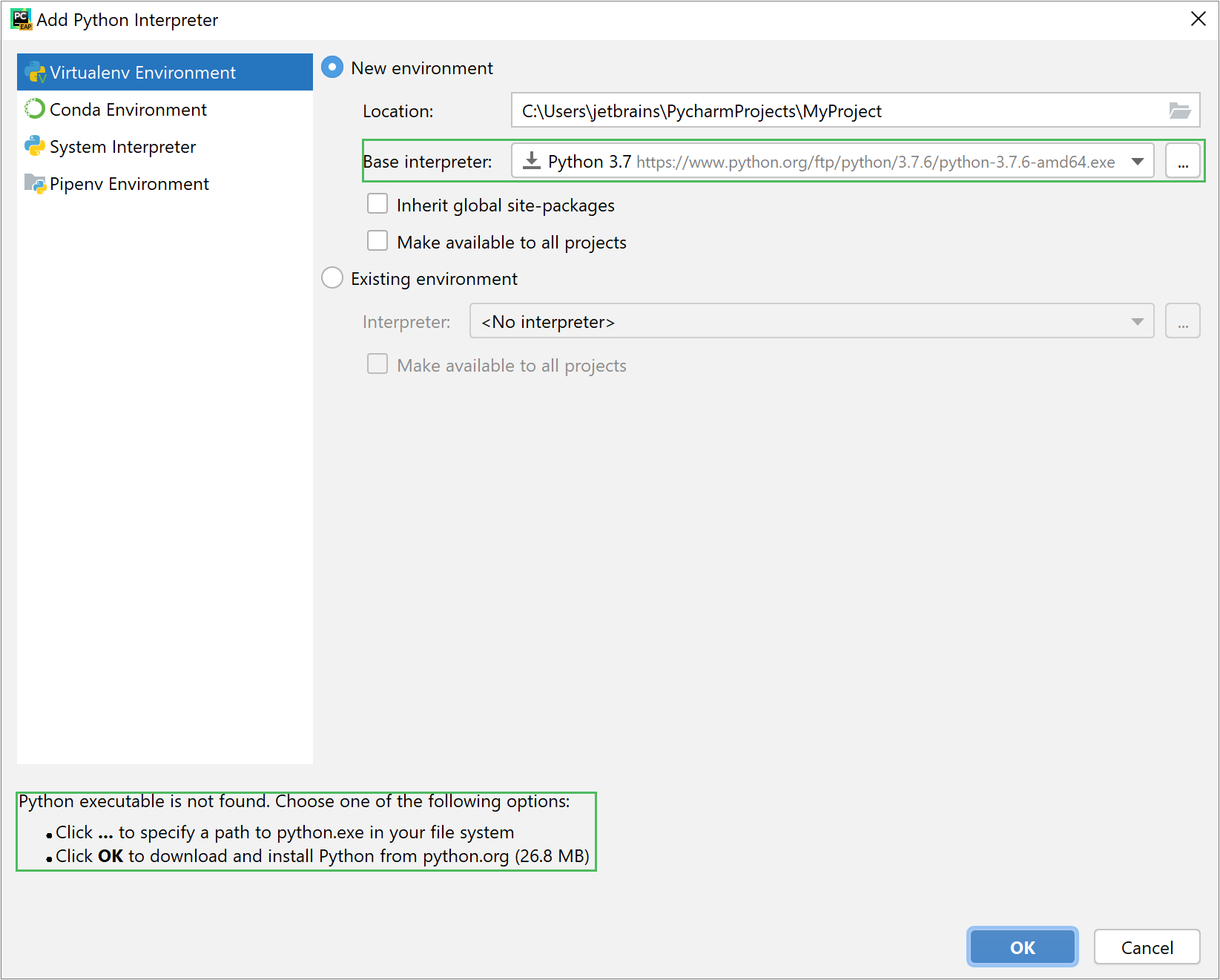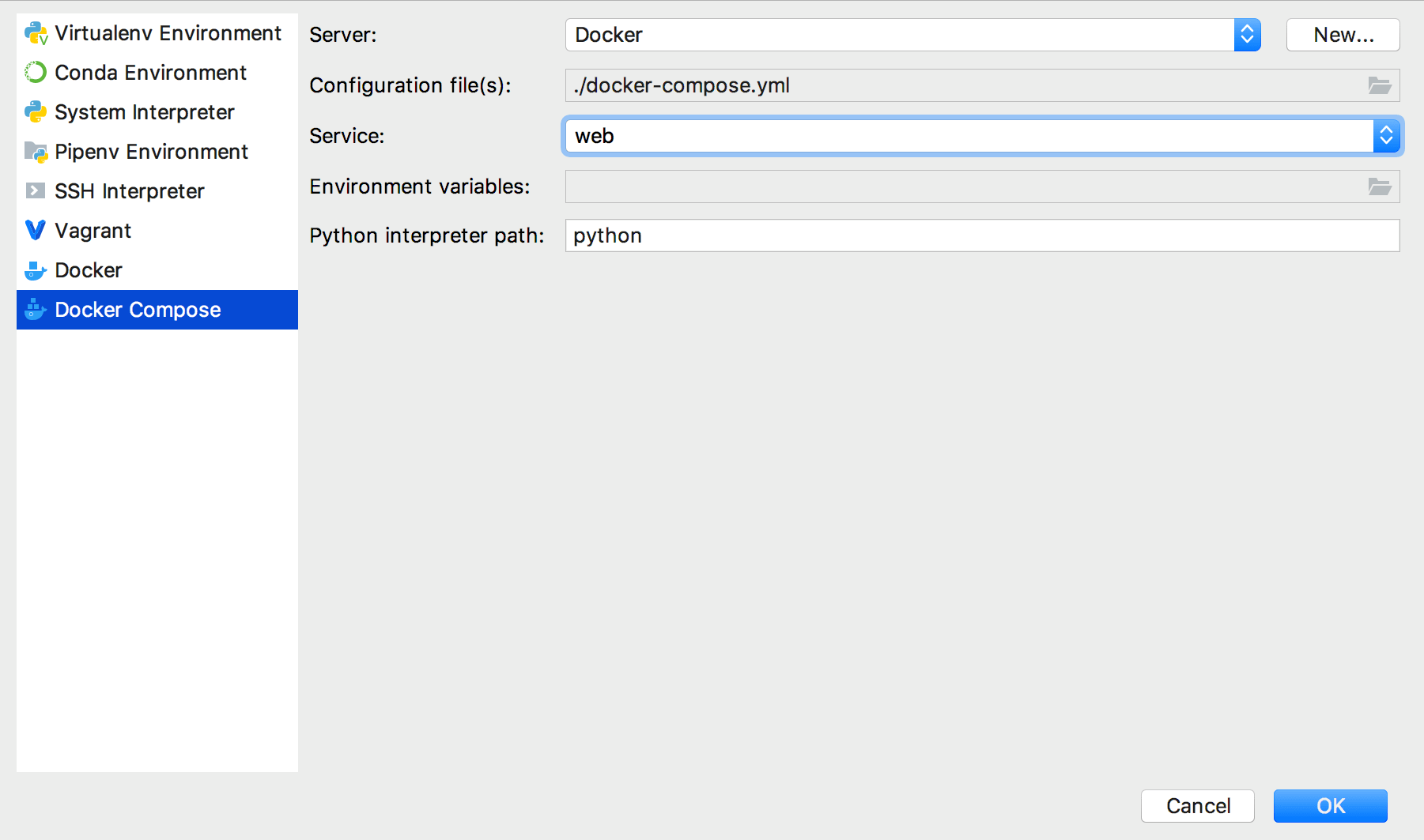invalid python interpreter selected for the project что делать
Пытаясь заставить PyCharm работать, продолжайте получать «интерпретатор Python не выбран»,
Я пытаюсь изучить Python и решил использовать PyCharm. Когда я пытаюсь запустить новый проект, я получаю диалог, в котором говорится: «No Python C: Python27 selected». У него есть раскрывающийся список, чтобы выбрать интерпретатор, но выпадающий пуст.
Ответов: 7
Вероятно, ваша проблема заключается в том, что вы не установили python. Это означает, что если вы используете Windows, вы не загрузили установщик для Windows, который вы можете найти на официальном сайте Python.
В случае, если у вас есть, есть вероятность, что PyCharm не сможет найти вашу установку Python, потому что она не находится в местоположении по умолчанию, которое обычно C:Python33 или virtualenv (по крайней мере для меня).
После того, как вы найдете необходимые бинарные файлы, вам нужно будет сказать, что PyCharm должны были выглядеть:
Затем вам нужно будет ввести interpreter в поле поиска:
Это откроет диалоговое окно. Обязательно выберите python.exe файл этого каталога, не дайте pycharm весь каталог. Он просто хочет переводчика.
Идти к File->Settings->Project Settings->Project Interpreter->Python Interpreters
На правой стороне будет знак «+». Перейдите к вашему двоичному файлу python, PyCharm выяснит остальное.
Эта ситуация возникла, когда я удалил метод и попытался его переустановить. Мой тот же самый переводчик, который работал раньше, внезапно прекратил работать. И эта ошибка произошла.
Я попытался перезагрузить свой компьютер, переустановить Pycharm, сделать недействительными кеши, ничего не получилось.
Затем я перешел сюда для переустановки переводчика: https://www.python.org/downloads/
Когда вы устанавливаете его, есть возможность исправить интерпретатор python.exe. Нажмите на нее. Моя IDE вернулась к нормальным условиям работы.
Во время установки python убедитесь, что вы выбрали «Установить для всех пользователей». Удалите python и выполните выборочную установку и установите флажок «Установить для всех пользователей».
Даже у меня такая же проблема, и я ошибся в том, что я не загружал файл MSI python. Вы получите его здесь: https://www.python.org/downloads/
После загрузки msi запустите настройку, и это решит проблему. После этого вы можете перейти в Файл-> Настройки-> Настройки проекта-> Переводчик проекта-> Переводчики Python
Configure a Python interpreter
Python interpreters in PyCharm
Python interpreters can be configured for a new project or for the current project (you can create a new interpreter or use one of the existing interpreters).
Setting an existing Python interpreter
Change the Python interpreter using the Python Interpreter selector
The Python Interpreter selector is located on the status bar. It is the most convenient and quickest way to switch the Python interpreter. Just click it and select the target interpreter:
Change the Python interpreter in the project settings
Select the target interpreter.
When PyCharm stops supporting any of the outdated Python versions, the corresponding Python interpreter is marked as unsupported.
When you change an SSH interpreter, you might need to synchronize local content with the target server. Mind a notification balloon in the lower-right corner. 
Auto-upload files to the server
Synchronize files and then enable auto-uploading
Modify a Python interpreter
You can specify an alternative interpreter name for the selected interpreter. The Python interpreter name specified in the Name field, becomes visible in the list of available interpreters. Click OK to apply the changes.
For remote interpreters (that are available in PyCharm Professional ) you can modify configuration parameters.
Creating a new Python interpreter
To add a new interpreter to the current project:
Do one of the following:
Press Ctrl+Alt+S to open the project Settings/Preferences and go to Project
Choose the interpreter type to add and perform the specific settings:
Note that SSH, WSL, Vagrant, Docker, and Docker Compose are available only for the commercial version of PyCharm. WSL is Windows specific.
If New environment is selected:
If PyCharm detects no Python on your machine, it provides two options: to download the latest Python versions from python.org or to specify a path to the Python executable (in case of non-standard installation).
Select the Make available to all projects checkbox if you want to reuse this environment when creating Python interpreters in PyCharm.
If Existing environment is selected:
Select the Make available to all projects checkbox if you want to reuse this environment when creating Python interpreters in PyCharm.
Click OK to complete the task.
If you have added the user base’s binary directory to your PATH environmental variable, you don’t need to set any additional options: the path to the pipenv executable will be autodetected.
Click OK to complete the task.
Click OK to save the changes and complete the task.
If New environment is selected:
Select the Python version from the list.
Select the Make available to all projects checkbox if you want to reuse this environment when creating Python interpreters in PyCharm.
If Existing environment is selected:
Select the Make available to all projects checkbox if you want to reuse this environment when creating Python interpreters in PyCharm.
Click OK to complete the task.
If PyCharm detects no Python on your machine, it provides two options: to download the latest Python versions from python.org or to specify a path to the Python executable (in case of non-standard installation).
You will need admin privileges to install, remove, and upgrade packages for the system interpreter. When attempting to install an interpreter package through an intention action, you might receive the following error message: 
Click OK to complete the task.
In the next dialog window, provide the authentication details to connect to the target server.
Select Password or Key pair (OpenSSL or PuTTY) and enter your password or passphrase. If Key pair (OpenSSL or PuTTY) is selected, specify:
Private key file : location of the file with a private key
Passphrase : similar to a password, it serves to encrypt the private key.
The RFC 4716 format for OpenSSH keys is not supported by PyCharm. See the workaround.
Click Next to proceed with the final configuration step.
You can also select the lowest checkbox to enable automatic upload of the local changes to the remote server.
In the left-hand pane of the Add Python Interpreter dialog, click Vagrant :
This results in showing the link to Vagrant host URL.
The Python interpreter path field displays the path to the desired Python executable. You can accept default, or specify a different one.
Select the Linux distribution and specify the path to the python executable in the selected Linux distribution. Typically, you should be looking for wsl.exe but you can specify any non default WSL distro.
Python interpreter path should have the default value:
Click OK to complete the task.
In the dialog that opens, select the Docker Compose option, from the drop-down lists select the Docker server, Docker Compose service (here web ), configuration file (here docker-compose.yml ) and Python interpreter path (here python ).
Next, wait while PyCharm starts your Docker Compose configuration to scan and index:
Click OK to complete the task.
When a remote Python interpreter is added, at first the PyCharm helpers are copied to the remote host. PyCharm helpers are needed to run remotely the packaging tasks, debugger, tests and other PyCharm features. Next, the skeletons for binary libraries are generated and copied locally. Also all the Python library sources are collected from the Python paths on a remote host and copied locally along with the generated skeletons. Storing skeletons and all Python library sources locally is required for resolve and completion to work correctly. PyCharm checks remote helpers version on every remote run, so if you update your PyCharm version, the new helpers will be uploaded automatically and you don’t need to recreate remote interpreter. SFTP support is required for copying helpers to the server.
Setting the default interpreter
In PyCharm, you can specify an interpreter that will be automatically set for all newly created projects.
From the main menu, select File | New Projects Setup | Settings for New Projects (on Window and Linux) or File | New Projects Setup | Preferences for New Projects (on macOS).
The change will become effective for all newly created projects in PyCharm.
Managing interpreter packages
For each interpreter, you can install, upgrade, and delete Python packages. By default, PyCharm uses pip to manage project packages. For Conda environments you can use the Conda package manager.
Cannot select python interpreter #3535
Comments
BlackTrackDragon commented Dec 3, 2018
Environment data
Actual behavior
I downloaded a new version of python and now i cannot select the exe-file.
If the error message appears i select the only one choice (the correct path) and after this i get the same error message again.
Expected behavior
Select the python interpreter and run my code.
Steps to reproduce:
The text was updated successfully, but these errors were encountered:
brettcannon commented Dec 3, 2018
BlackTrackDragon commented Dec 3, 2018
I’m using powershell.
No, that also does’nt work. «python.pythonPath» is set to «python». When i overwrite this setting with the absolute path i get the same error message again.
shjohnson-pi commented Dec 5, 2018
I also had a problem with the error message asking me to select a Python Interpreter, even though I had «python.pythonPath»: «.venv/bin/python», in my workspace settings. (Pipenv environment, Linux Mint 18)
I had a flag in my
/.bashrc to show all python warnings: export PYTHONWARNINGS=»default»
I tracked down the problem to a python file that prints out json info about the current python intrepreter. The problem was that the warnings (in python 3.7) were printed at the top, causing invalid json.
Here is an example of running the file by hand. I also showed that by redirecting stderr, then only the json was printed out. The extension could do this to prevent this bug from happening when the user wants to show warnings.
I temporarily fixed my problem by commenting out export PYTHONWARNINGS=»default» in
PyCharm doesn’t detect interpreter
I’m new to programming and just started a course on Python. I want to use PyCharm, so I downloaded and intalled it (v. 4.5, community edition). I had previously installed Python 3.5 64-bit from python.org (I’m using Windows 10).
To start using PyCharm, I need a project interpreter, which I can select in the settings. As far as I’m concerned, the interpreter is «py.exe», but when I select it, I get this error message: «The selected file is not a valid home for Python SDK». I also tried to use every file whose name contained «python» or «py», and failed.
On every website and video I see, they select a file called «python.exe», but they’re using Python 3.4 or a previous version. I checked that PyCharm supports 3.5 («Initial support for Python 3.5»).
Is there anything I’m doing wrong? What should I do to be able to use PyCharm?
All replies are appreciated. Thanks in advance.
7 Answers 7
file > new project settings > project Interpreter > click in the drop down and select ‘show all’ > click the ‘+’ button >
Now, in the Virtualenv Environment tab under the New environment radio button, check the path in the ‘Base interpreter:’ field. For me, mine was set to an invalid path. Once I had corrected the path to point to python.exe I recreated my new project and PyCharm built the virtualenv.
For me there was a bit more too. When creating the new project I expanded the drop down and had to verify the directory where the venv directory was being created. Once I had corrected the path here I had to click around a bit to get it to let me create the project.
I’m going to chaulk this up to a bug. I’m using Community edition.
When creating a project in PyCharm, if the interpret is not already selected, in the drop down menu under the projects «Location:», you can click the gear-looking icon to the right of the interpreter option, and click «Add Local»; then select the file location of the python.exe file that you have installed. It will probably be C:\Python35\Python.exe
I faced a Similar issue and was not able to find Python interpreter anywhere on the system.
The problem with it was that python was installed directly with default settings and there was no exe found in
and to solve this i tried uninstalling and reinstalling with custom settings and selecting allow for all users as well which did the trick and path was set correctly to
After which Pycharm was able to detect the interpreter on this path.
PyCharm project interpreter problem Resolved
I installed anaconda python distribution (Anaconda3-5.0.1-Windows-x86_64.exe) from the anaconda website. https://anaconda.org/anaconda/python
What it actually did was it re-installed my Python3.6.3 (pertinent to mention I have windows10, with pyCharm community & python 3.5 already but with the interpreter problem and while installing anaconda I chose the following settings and disabled my antivirus before my anaconda installation):
Wow! my pyCharm started working for me,
Resolution : Python6.3 re-installation with proper custom setting
make a python test test1.py program file to print «hello python test world»
Run
success test Run
worth to mention Anaconda Jupyter is a web based can also be used in case novice user are still having problems
Python Interpreter
Interpreters
When PyCharm stops supporting any of the outdated Python versions, the corresponding Python interpreter is marked as unsupported.
Click this button to configure an interpreter:
From the list, choose the one to be added:
Add : choose this option to add a locally residing Python interpreter. This includes also virtual environments and Conda environments. Also, choose this option to add a Python interpreter that resides remotely.
Show all : choose this option to open the list of all interpreters, available to the current project.
Packages
This table shows the packages installed locally.





















